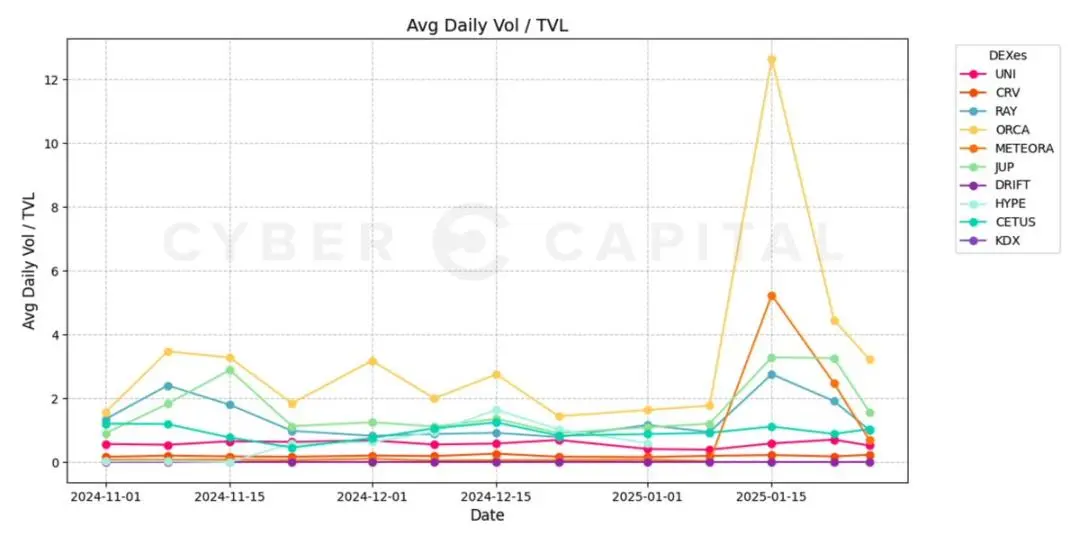In-depth analysis of the four major DEXs on Solana: Raydium, Jupiter, Orca, and Meteora, which one is better?
Original Title: Introduction: Solana's Evolving DeFi Landscape
Original Author: vik0nchain, Cyber Capital Researcher
Original Translation: Luffy, Foresight News
From the fourth quarter of 2024 to early 2025, the competitive landscape of Solana's DeFi ecosystem is gradually emerging, primarily reflected in the rise of aggregators, the abstraction of user experience (UX), significant integrations, and the continuously evolving token economic standards. Although these changes were initially not obvious, recent data has clearly shown their impact, particularly highlighted by the redistribution of liquidity, fee generation, and changes in market share.
This analysis delves into the liquidity positioning of major decentralized exchanges (DEXs) based on Solana—Raydium, Jupiter, Orca, and Meteora—focusing on their advantages, disadvantages, and potential investment impacts relative to existing and emerging competitors.
Investment Analysis Framework
Raydium (RAY) Outlook: Optimistic with Deep Liquidity and Buyback Advantages
· Dominance in Liquidity and Trading Volume: Raydium remains the most liquid and frequently used decentralized exchange in the Solana ecosystem. Over 55% of trades routed through Jupiter are settled on Raydium. Additionally, Raydium occupies a leading market position among decentralized exchanges across all blockchains, sometimes even surpassing the long-term leader Uniswap, while its fully diluted valuation (FDV) and market cap are only about one-third of Uniswap's.
· Raydium/Uniswap Fully Diluted Valuation Ratio: $2.872828346 billion / $9.102379018 billion = 31.5%
· Raydium/Uniswap Market Cap Ratio: $1.505604427 billion / $5.465824531 billion = 27.5%

· Pump.fun Integration: Key partnerships, including the integration with Pump.fun, have enhanced trading volume and protocol stickiness due to the migration of all new Meme pools to Raydium.
· Token Buyback: Raydium's 12% fee buyback plan has repurchased over 10% of the total supply of tokens, significantly alleviating selling pressure. Notably, the amount repurchased by Raydium far exceeds that held by centralized exchanges.

Jupiter (JUP) Outlook: Optimistic as a Market-Leading Aggregator
· Liquidity Aggregation Advantage: Jupiter plays a key role as the dominant aggregator on Solana.
· Acquisition of Moonshot: The acquisition of Moonshot enables Jupiter to integrate deposit/withdrawal channels within its decentralized exchange, enhancing competitiveness by streamlining the user experience.
· Unlocking Pressure: Jupiter faces a 127% increase in supply due to token unlocks, bringing mid-term inflation risks. Although a buyback mechanism was recently announced, internal estimates suggest an annual buyback rate of 2.4%, which provides some support for the token economy but has limited impact in competition with Raydium.
· Business Model: Since aggregator fees are charged on top of the underlying protocol fees, the aggregator model faces challenges in low-fee dimensions.
· Lack of Competitors: As the first aggregator on Solana, Jupiter lacks strong competitors.
Meteora Outlook: Optimistic as an Emerging Liquidity Aggregator
· Efficient Liquidity Aggregation: Unlike standalone decentralized exchanges, aggregators like Meteora inherently have lower downside risk and more stable capital efficiency.
· Token Issuance Catalyst: The successful issuance of Meteora tokens could change liquidity preferences, providing long-term support for its market positioning. Unlike industry LP leader Kamino, MET points are not publicly displayed on the user interface. Additionally, there has been no official announcement regarding airdrops since the MET points system was first announced over a year ago. Although liquidity providers can earn higher yields elsewhere in the ecosystem (e.g., lulo.fi), market positioning and airdrop expectations may be the main drivers for liquidity providers.
· Total Value Locked (TVL) Retention: Meteora has achieved growth through significant events such as the Pengu airdrop and the launch of Trump and Melania-related Memecoins. While the trading volume/TVL ratio of many trading pairs increased during the Memecoin launch due to temporary demand, Meteora's total locked value has continued to rise after the event, indicating good retention.
· Integration Development: Virtuals migrated to Solana in the first quarter of 2024 and announced integration with Meteora's liquidity pool.


Orca Outlook: Pessimistic with Insufficient Liquidity Retention
· Insufficient Liquidity Depth: Despite being highly efficient, Orca's pool sizes are significantly smaller than Raydium's, leading to higher slippage for large trades.
· Market Positioning Issues: Jupiter's routing mechanism prioritizes trading platforms with deeper liquidity, making emerging low-liquidity decentralized exchanges and liquidity pools less attractive. The emergence of Meteora as a liquidity aggregator further limits the competitive survival of non-dominant decentralized exchanges within the routing framework, as routing only occurs when slippage costs are lower than Meteora's fee premium, a situation that is extremely rare outside of surging market demand.
· Limited Incentives for Liquidity Providers: Orca lacks strong liquidity mining strategies, resulting in lower retention rates for long-term liquidity providers.
· Inefficient Capital Allocation: Unlike Meteora, Orca has not implemented automated yield optimization, requiring manual management of LPs, leading to a more cumbersome user experience.
· Unfavorable Liquidity Trends: The upcoming launch of Meteora tokens may completely attract liquidity providers away from Orca, making its situation even more difficult.
· Insufficient Integrations: Failing to partner with Pump.fun at the beginning of 2024 and recently missing out on collaboration with Virtuals highlights its competitive disadvantage in acquiring emerging retail-driven application order flow. Without upcoming catalysts to reverse this trend, liquidity migration may continue. These factors have led to Orca's inability to retain the additional user base gained during peak network demand.
Key Catalysts and Risks
Catalysts to Watch
· RAY Buyback vs. Centralized Exchange Holdings: The buyback rate of RAY has now surpassed the total amount of RAY held by centralized exchanges, reinforcing token scarcity.
· Total Value Locked Growth Trend: The sustained dominance of Raydium, Jupiter, and Meteora indicates the sustainability of long-term liquidity. The stickiness of emerging protocols under high-pressure market conditions is noteworthy and should not be overlooked.
· Partnerships: Just as the integration with Pumpfun brought significant liquidity to Raydium, the integration of Meteora with Virtuals may have a similar effect. Given the impact of such large-scale collaborations on liquidity and total locked value, partnerships with lesser-known participants are of great interest.
· Meteora's Token Issuance: This event could mark a turning point in the liquidity distribution of decentralized exchanges on Solana.
· Fee vs. Market Cap Ratio: Orca demonstrates extremely high efficiency during months of strong demand, but its insufficient liquidity retention hinders long-term competitiveness. Conversely, JUP faces the opposite situation, constrained by its business model. Compared to the latest "hot project" Hyperliquid, Raydium generates ten times the fees at one-eighth of the fully diluted valuation.

Risks
· Inflation Pressure on JUP: Although Jupiter's aggregator position is solid, its large token supply may cause short-term price pressure. Decline in Orca's Market Share: If the trend of liquidity provider migration continues, Orca may face ongoing liquidity loss. Meteora Airdrop and Token Economic Execution Risks: Despite strong early growth in total locked value, its token economy and incentive structure remain untested.
Conclusion and Investment Outlook
The landscape of decentralized exchanges on Solana is shifting towards higher efficiency and deeper liquidity concentration. Raydium's excellent liquidity positioning, proactive buyback mechanism, and market dominance make it a highly confident investment in decentralized exchanges. Jupiter's role as an aggregator remains crucial and provides competitive barriers, but token supply dilution poses short-term resistance. Orca, once a competitive player, faces severe challenges in liquidity retention and capital efficiency, becoming an increasingly fragile asset, indicating a dilemma of missing key integrations and struggling to compete directly with mature participants. Meteora is expected to rise after successfully launching its upcoming tokens.
According to our current theory, investment positions in decentralized exchanges should focus on the leading decentralized exchanges, decentralized exchange aggregators, and liquidity aggregators within a given ecosystem, with emerging participants that meet catalyst criteria also holding small positions.










